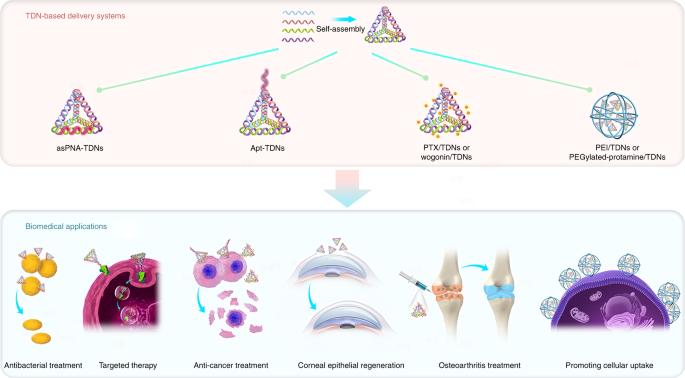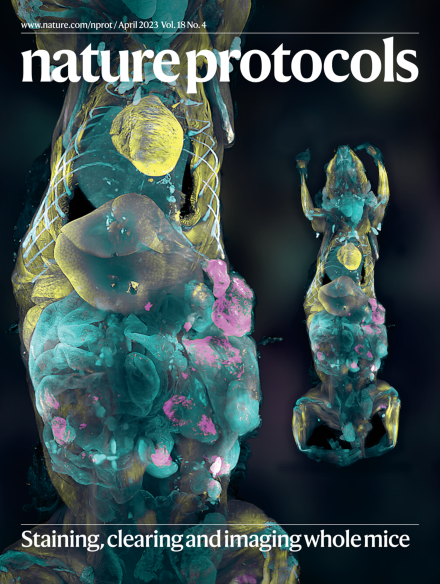基于四面体 DNA 纳米结构的多功能复合物在药物输送和生物医学治疗中的设计、制造和应用
IF 13.1
1区 生物学
Q1 BIOCHEMICAL RESEARCH METHODS
引用次数: 150
摘要
虽然有机纳米材料和无机纳米粒子具有固有的灵活性,有利于进行功能修饰、增加细胞内吸收和可控药物释放,但其潜在的细胞毒性和缺乏特异性仍然引起人们对其安全性的担忧。四面体 DNA 纳米结构具有天然的生物相容性、结构稳定性、无与伦比的可编程性、易于内化和可编辑功能等优点,因此有望成为药物输送和生物医学治疗的替代载体。在这里,我们介绍了一种基于自组装四面体 DNA 纳米结构(TDN)的多功能递送系统的设计、制造、纯化、表征和潜在的生物医学应用。首先,依靠沃森-克里克碱基配对,四条 DNA 单链通过一个杂交步骤形成了一个简单而典型的金字塔结构。然后,该方案详细介绍了四种不同的修饰方法,包括用反义肽核酸替换单条DNA链的短序列、在顶点添加一个aptamer、直接与紫杉醇和沃戈宁等小分子量药物孵育以及涂覆阳离子聚合物等保护剂。这些经过修饰的基于 TDN 的复合物可促进所传递分子的细胞内吸收和生物稳定性,在靶向治疗、抗菌抗癌治疗和组织再生领域大有可为。整个组装和表征过程取决于货物类型和改性方法,耗时 2 小时到 3 天不等。在本论文中,作者介绍了基于自组装 TDN 的多功能递送系统的设计、制造、纯化、表征和潜在的生物医学应用。本文章由计算机程序翻译,如有差异,请以英文原文为准。

Design, fabrication and applications of tetrahedral DNA nanostructure-based multifunctional complexes in drug delivery and biomedical treatment
Although organic nanomaterials and inorganic nanoparticles possess inherent flexibility, facilitating functional modification, increased intracellular uptake and controllable drug release, their underlying cytotoxicity and lack of specificity still cause safety concerns. Owing to their merits, which include natural biocompatibility, structural stability, unsurpassed programmability, ease of internalization and editable functionality, tetrahedral DNA nanostructures show promising potential as an alternative vehicle for drug delivery and biomedical treatment. Here, we describe the design, fabrication, purification, characterization and potential biomedical applications of a self-assembling tetrahedral DNA nanostructure (TDN)–based multifunctional delivery system. First, relying on Watson-Crick base pairing, four single DNA strands form a simple and typical pyramid structure via one hybridization step. Then, the protocol details four different modification approaches, including replacing a short sequence of a single DNA strand by an antisense peptide nucleic acid, appending an aptamer to the vertex, direct incubation with small-molecular-weight drugs such as paclitaxel and wogonin and coating with protective agents such as cationic polymers. These modified TDN-based complexes promote the intracellular uptake and biostability of the delivered molecules, and show promise in the fields of targeted therapy, antibacterial and anticancer treatment and tissue regeneration. The entire duration of assembly and characterization depends on the cargo type and modification method, which takes from 2 h to 3 d. In this protocol, the authors describe the design, fabrication, purification, characterization and potential biomedical applications of a self-assembling TDN-based multifunctional delivery system.
求助全文
通过发布文献求助,成功后即可免费获取论文全文。
去求助
来源期刊

Nature Protocols
生物-生化研究方法
CiteScore
29.10
自引率
0.70%
发文量
128
审稿时长
4 months
期刊介绍:
Nature Protocols focuses on publishing protocols used to address significant biological and biomedical science research questions, including methods grounded in physics and chemistry with practical applications to biological problems. The journal caters to a primary audience of research scientists and, as such, exclusively publishes protocols with research applications. Protocols primarily aimed at influencing patient management and treatment decisions are not featured.
The specific techniques covered encompass a wide range, including but not limited to: Biochemistry, Cell biology, Cell culture, Chemical modification, Computational biology, Developmental biology, Epigenomics, Genetic analysis, Genetic modification, Genomics, Imaging, Immunology, Isolation, purification, and separation, Lipidomics, Metabolomics, Microbiology, Model organisms, Nanotechnology, Neuroscience, Nucleic-acid-based molecular biology, Pharmacology, Plant biology, Protein analysis, Proteomics, Spectroscopy, Structural biology, Synthetic chemistry, Tissue culture, Toxicology, and Virology.
 求助内容:
求助内容: 应助结果提醒方式:
应助结果提醒方式:


